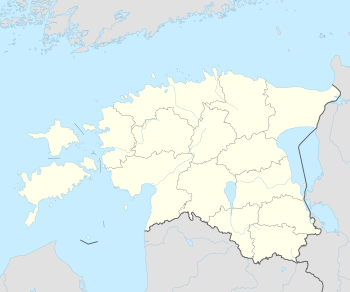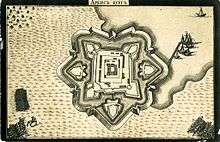Kuressaare Castle
| Kuressaare Castle | |
|---|---|
| Kuressaare linnus | |
| Kuressaare, Estonia | |
 | |
 Kuressaare Castle | |
| Coordinates | 58°15′00″N 22°29′00″E / 58.25°N 22.48333°E |
| Type | Castle |
| Site history | |
| Built | 1380s (possibly earlier) |
| Built by | Bishop of Ösel–Wiek (Saare-Lääne) |
Kuressaare Castle (Estonian: Kuressaare linnus; German: Schloss Arensburg), also Kuressaare Episcopal Castle, (Estonian: Kuressaare piiskopilinnus), is a castle in Kuressaare on Saaremaa island, in western Estonia.
History
The earliest written record mentioning Kuressaare castle goes back to the 1380s, when the Teutonic Order began constructing it for the bishops of Ösel-Wieck.[1] Some sources claim that the first castle was built in wood.[2][3] As the inhabitants of Saaremaa put up stiff resistance to foreign efforts to Christianise them, the castle was doubtlessly built as part of a wider effort by the crusaders to gain control over the island. From the outset, it was a stronghold belonging to the bishop of Saare-Lääne (German: Ösel-Wiek) and remained one of the most important castles of the Bishopric until its dissolution in the course of the Livonian War.[4]

In 1559, Denmark seized control over Saaremaa and Kuressaare castle. During this time, the fortifications were modernised. Following the Peace of Brömsebro, which ended the 1643-1645 war between Sweden and Denmark, Saaremaa passed into Swedish hands. The Swedes continued the modernisation of the fortress until 1706. Following the Great Northern War, Saaremaa and Kuressaare castle became a part of the Russian Empire.[4]
As the frontiers of the Russian Empire gradually were pushed further west, Kuressaare gradually lost its strategic value. Especially after the Finnish War and the Third Partition of Poland, military focus shifted away from Estonia. In 1836, following the construction of fortress of Bomarsund on Åland, the Russian garrison at Kuressaare withdrew.[4] The fact that Kuressaare castle was not part of the fighting during the Crimean War is also indicative of its lost strategic importance.[5] In the 19th century, there was a poorhouse located in the castle.[4]
In 1904–12 the castle was restored by architects Hermann Seuberlich and Wilhelm Neumann.[4] It underwent a second restoration in 1968, this time led by architect Kalvi Aluve.[6]
Today the castle houses Saaremaa Museum.[4]
Architecture
Kuressaare castle is considered one of the best preserved medieval fortifications in Estonia.[1]
The castle is late Gothic in style and characterised by a simplicity in forms. The central, so-called convent building, is a square building around a central courtyard. The so-called defence tower, in the northern corner, reaches 37 metres (121 ft). A defence gallery with battlements running along the top of the building was restored in the 1980s. The portcullis and gate defences are also reconstructions. Inside, the castle is divided into a cellar which was used for storage and equipped with a sophisticated hypocaust heating system, and the main floor, which housed the most important rooms of the castle. Here, a cloister surrounds the courtyard and connects all the main rooms. Notable among these are the refectory, the dormitory, the chapel and the bishop's living quarters. In the latter, eleven baroque carved epitaphs of noblemen from Saaremaa are displayed.[4][7]
At the end of the 14th and beginning of the 15th century, a wall, 625 metres (2,051 ft) long, was built around the castle. With the increased power of firearms, additional defensive elements were added between the 16th and 17th centuries. Erik Dahlbergh designed the Vauban-type fortress with bastions and ravelins that still is largely intact. When the Russian garrison left the fortress in 1711 following the Great Northern War, they deliberately blew up much of the fortifications and the castle, but later restored some of it.[4] In 1861, conversion of the bastions into a park began under the supervision of Riga architect H. Göggingen.[8]
- Bridge to the castle
- Main gate
 Inner court
Inner court- Watchtower
See also
References
- 1 2 Viirand, Tiiu (2004). Estonia. Cultural Tourism. Kunst Publishers. pp. 176–178. ISBN 9949-407-18-4.
- ↑ O'Connor, Kevin (2006). Culture And Customs of the Baltic States. Greenwood Publishing Group. p. 207. ISBN 978-0-313-33125-1. Retrieved 4 June 2012.
- ↑ Jarvis, Howard; Ochser, Tim (2 May 2011). DK Eyewitness Travel Guide: Estonia, Latvia & Lithuania. Dorling Kindersley. p. 32. ISBN 978-1-4053-6063-0. Retrieved 4 June 2012.
- 1 2 3 4 5 6 7 8 Saaremaa Museum "History of the castle and fortress" Check
|url=value (help). Retrieved 26 December 2012. - ↑ Taylor, Neil (2010). Estonia (6 ed.). Bradt Travel Guides Ltd. p. 254. ISBN 978-1-84162-320-7.
- ↑ Lang, V.; Laneman, Margot (2006). Archaeological research in Estonia, 1865-2005. Tartu University Press. p. 185. Retrieved 4 June 2012.
- ↑ Tvauri, Andres (Autumn 2009). "Late medieval hypocausts with heat storage in Estonia". Baltic Journal of Art History. Institute of History and Archaeology of the University of Tartu: 52.
- ↑ Kuressaare Municipality "Kuressaare castle park" Check
|url=value (help). Retrieved 26 December 2012.
External links
| Wikimedia Commons has media related to Kuressaare Castle. |